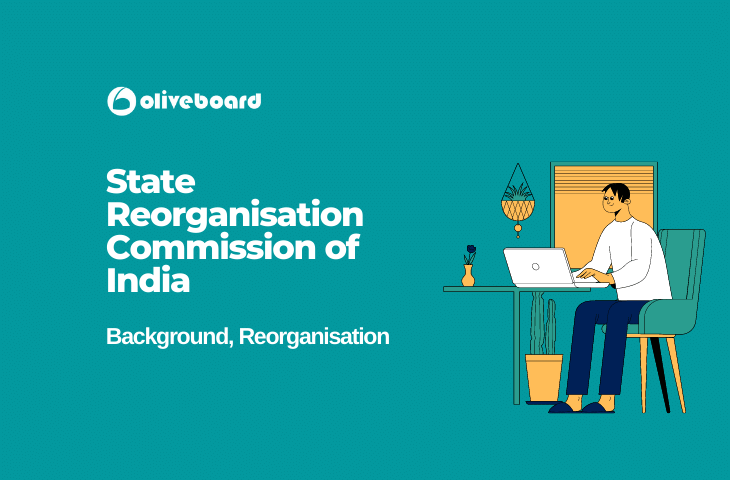The Government of India formed the State Reorganisation Commission of India (SRC). It was formed to reorganize the state boundaries in August 1953. Prime Minister Jawaharlal Nehru appointed the Commission at first. The Commission comprises KM Panikkar, Fazal Ali, and H.N. Kunzru submitted their report after two years of study in October 1955. They suggested some modifications and recommendations regarding state reorganization. It was mostly based on cultural landscapes, especially languages. This gave rise to the implementation of the States Reorganisation Act, 1956.
Why was Reorganisation needed?
After independence, state reorganization was needed due to two reasons:
- Developing a new administrative setup for India included princely states and British provinces.
- A new India had been formed with a legacy of regional governance; hence it was not possible to abandon the regional governments.
The above factors made the reorganization of states and provinces necessary. It was challenging due to India’s extreme cultural, social, political, economic, administrative, and physical diversities.
Therefore, India adopted interim federalism immediately after independence. It was done temporarily, and they formed four parts comprising states as mentioned below:
| Category | Details | Administrator | States |
| A | All the British Provinces | Elected governor and the state legislature | There are 9 states here – Bihar, Bombay, East Punjab, Assam, Orissa, Madras, Madhya Pradesh, West Bengal, and Uttar Pradesh. |
| B | Princely states or the groups of the covenanting groups | Rajpramukh | There are 9 states here – Madhya Bharat, Mysore, Hyderabad, Jammu and Kashmir, Rajasthan, East Punjab States Union (PEPSU), Vindhya Pradesh, Travancore-Cochin, and Saurashtra. |
| C | Princely states (medium-sized) | Chief Commissioner | There are 10 states here – Ajmer, Bhopal, Bilaspur, Coorg, Coochbehar, Delhi, Kutch, Himachal Pradesh, Kutch, Manipur, and Tripura. |
| D | Union Territory or special category states | Governor is appointed by the President of India | Andaman and Nicobar Islands |
Background:
- These states were formed based on the principle of linguistic states. The Fazl Commission used the data of Census 1951 as a reference to reorganise the states.
- Mostly the demand for separate states on linguistic category was from South India. From the beginning, the Fazl Ali Commission rejected the idea of ‘One language, One state’ for India.
- With some modifications and census’ facts received, the Commission reorganised the states, which the public accepted.
- In 1960, the state of Bombay was divided into Gujarat and Maharashtra.
- In 1961, Daman and Diu and Goa were liberated from Portugal and were given the status of Union Territories.
- In 1963, Nagaland state was formed.
- In 1966, Punjab state was divided into 4 regions based on languages. Hence, Punjab and Haryana were formed in 1966 based on their dialects.
- After the above incident, Chandigarh was claimed by both Haryana and Punjab. Therefore, Chandigarh was given the status of Union Territory.
- Kangra district (purely Hindi speaking region) was given to Himachal Pradesh. Himachal Pradesh was a state at that time, and later the Central Government gave it the status of a State fully in 1971.
- Already there were two states – Assam and Nagaland in Northeast India. In 1971, Northeast India was divided into 2 UTs and 5 states due to the NE India State Reorganisation Act, 1971. New states, namely Meghalaya, Tripura, and Manipur, were formed. Meghalaya was no longer part of Assam. Manipur and Tripura came under Union Territories, but now they were declared as states.
- In 1975, the Central Government added the state of Sikkim to Northeast India due to its geo-strategic importance.
- In 1987, two UTs, Mizoram and Arunachal Pradesh, were declared States due to their geo-strategic importance and local demands.
- In 1987, Goa was declared a state; however, Daman and Diu remained UT.
- In 2000, three new states, namely – Chhattisgarh, Jharkhand, and Uttarakhand, were formed. These regions were declared as States due to their backwardness. Another reason was that the local tribes in these regions were afraid that they would become the minority due to the settlement of outsiders.
- In 2014, the state of Telangana was formed, which was earlier the part of Hyderabad’s princely states. The demand for Telangana was made at the time of independence, but the government merged it with Andhra Pradesh due to the Telugu language.
- In 2019, Jammu and Kashmir and Ladakh (including the two districts – Leh and Kargil) received the status of Union Territories. The President approved it on the recommendation of the Parliament. This decision dismantled Article 370 of the Constitution, and hence the Jammu and Kashmir Reorganization Act, 2019, was enacted.
Conclusion:
Some of the incidents in history proved that the reorganization of the States and Union Territories was necessary to maintain the peace and unity of India. Some special safeguards were also provided for linguistic minorities by the Commission. It was a major step towards the division of India into several States and UTs.
FAQs:
The first state of independent India was Andhra. On 1st November 1956, the state of Andhra Pradesh was formed.
India had more than 500 disjointed princely states at the time of independence. So, it was originally divided into four parts – Part A, Part B, Part C, and Part D. Later, further subdivisions and re-classification were made due to reasons like political, social, economic, etc.
The reasons for reorganizing the states were not only based on languages but several political, social, economic, backward area development, cultural affiliations were taken into account.
Late Prime Minister Jawaharlal Nehru appointed the Commission first in 1953.
It was stated by the Commission that India can not be divided based on languages. Hence the idea of one language, one state, is not possible to form in India.
